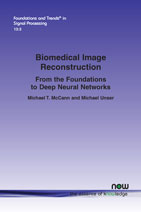Biomedical Image Reconstruction: From the Foundations to Deep Neural Networks
By Michael T. McCann, EPFL, Switzerland, michael.mccann@epfl.ch | Michael Unser, EPFL, Switzerland, michael.unser@epfl.ch
Abstract
This tutorial covers biomedical image reconstruction, from the foundational concepts of system modeling and direct reconstruction to modern sparsity and learning-based approaches. Imaging is a critical tool in biological research and medicine, and most imaging systems necessarily use an image reconstruction algorithm to create an image; the design of these algorithms has been a topic of research since at least the 1960’s. In the last few years, machine learning-based approaches have shown impressive performance on image reconstruction problems, triggering a wave of enthusiasm and creativity around the paradigm of learning. Our goal is to unify this body of research, identifying common principles and reusable building blocks across decades and among diverse imaging modalities. We first describe system modeling, emphasizing how a few building blocks can be used to describe a broad range of imaging modalities. We then discuss reconstruction algorithms, grouping them into three broad generations. The first are the classical direct methods, including Tikhonov regularization; the second are the variational methods based on sparsity and the theory of compressive sensing; and the third are the learning-based (also called data-driven) methods, especially those using deep convolutional neural networks. There are strong links between these generations: classical (first-generation) methods appear as modules inside the latter two, and the former two are used to inspire new designs for learning-based (third-generation) methods. As a result, a solid understanding of all three generations is necessary for the design of state-of-the-art algorithms.
Biomedical Image Reconstruction: From the Foundations to Deep Neural Networks
Biomedical imaging is a vast and diverse field. There are a plethora of imaging devices using light, X-rays, sound waves, magnetic fields, electrons, or protons, to measure structures ranging from nano to macroscale. In many cases, computer software is needed to turn the signals collected by the hardware into a meaningful image. These computer algorithms are similarly diverse and numerous.
This survey presents a wide swath of biomedical image reconstruction algorithms under a single framework. It is a coherent, yet brief survey of some six decades of research. The underpinning theory of the techniques are described and practical considerations for designing reconstruction algorithms for use in biomedical systems form the central theme of each chapter.
The unifying framework deployed throughout the monograph models imaging modalities as combinations of a small set of building blocks, which identify connections between modalities Thus, the user can quickly port ideas and computer code from one to the next. Furthermore, reconstruction algorithms can treat the imaging model as a black. box, meaning that one algorithm can work for many modalities. This provides a pragmatic approach to designing effective reconstruction algorithms.
This monograph is written in a tutorial style that concisely introduces students, researchers and practitioners to the development and design of effective biomedical image reconstruction algorithms.
